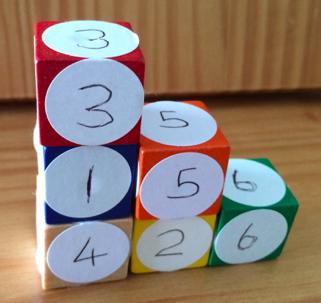Or search by topic
Number and algebra
Geometry and measure
Probability and statistics
Working mathematically
Advanced mathematics
For younger learners
Six Numbered Cubes



- Problem
- Student Solutions
- Teachers' Resources
Six Numbered Cubes
We are using six cubes. Each cube has six faces of the same number.

The shape we make has to be only one cube thick. The shape on the left is built correctly, but the shape on the right would not be allowed as it is two bricks thick in places.
The total of the shape on the left is 70. Can you see why?
Start by making a staircase shape. An example is shown below:

a) What is the highest total you can make by using this staircase shape?
b) What is the lowest total you can make by using this staircase shape?
c) How did you calculate the totals for a) and b) above? Why did you choose the method(s) that you did?
d) Have a go at making a total of 75 using a staircase shape.
CHALLENGE 2
How can you be sure this is the lowest total whatever the shape?
Can the lowest total be found in more than one way? Justify your answer.
How can you be sure this is the highest total whatever the shape?
Can the highest total be found in more than one way? Justify your answer.
If the cubes are arranged in a single vertical tower (like this)

then no matter what order the cubes are in, the total cannot be 80.
This problem featured in a round of the Young Mathematicians' Award 2014.
Why do this problem?
This problem gives pupils the opportunity to use knowledge and skills associated with spatial awareness, addition and multiplication, and to explain their thinking. It also involves keeping to rules that must be followed. The further they progress through the activity, the greater the opportunities for learners to use a whole variety of
problem-solving skills. The activity also opens out the possibility of pupils asking “I wonder what would happen if . . .?”
Pupils' curiosity may be easily aroused while trying to find solutions to the challenges.
Possible approach
It would be good to demonstrate the kind of arrangements that are allowed as well as making those that break the rules for the pupils to decide on what is okay.
You may decide that you want the pupils to work in groups of three or four. One set of numbered cubes will be needed for each group. Having set them the first challenge, it may be sufficient to stop there. Challenges 2, 3 and 4 can be introduced straight away or left to another occasion.
It is worth noting that in the "steps" arrangement as shown on the problem page, the 5 and 6 both have four faces showing; the 1 and 4 both have three faces showing. So, the cubes that have the same number of faces showing can be swapped allowing for more arrangements to be possible.
Key questions
How are you working out the totals?
How have you got to this arrangement?
Tell me about your shape.
How sure are you that ...?
Possible support
Some pupils may require help with getting the cubes to stack. Those who are unable to record their arrangements could have them photographed.
You may also like
Pebbles
Place four pebbles on the sand in the form of a square. Keep adding as few pebbles as necessary to double the area. How many extra pebbles are added each time?
Bracelets
Investigate the different shaped bracelets you could make from 18 different spherical beads. How do they compare if you use 24 beads?
Sweets in a Box
How many different shaped boxes can you design for 36 sweets in one layer? Can you arrange the sweets so that no sweets of the same colour are next to each other in any direction?

